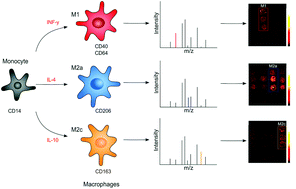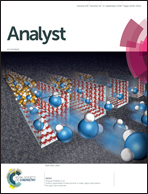Strategy for marker-based differentiation of pro- and anti-inflammatory macrophages using matrix-assisted laser desorption/ionization mass spectrometry imaging
Abstract
Macrophages are large phagocytes playing a crucial role in the development and progression of atherosclerosis. The phenotypic polarization and activation of macrophages in atherosclerotic plaques depends on their complex micro-environment and at the same time has a major impact on the vulnerability or stability of advanced atherosclerotic lesions. Many in vitro and in vivo studies have been designed to define markers for macrophage subtypes to better understand the mechanism of plaque progression but they have rather added to the confusion. Nonetheless, some of the in vitro defined macrophage subtypes, like the pro-inflammatory M1 or the anti-inflammatory M2a/b/c macrophage, have been shown to be present in atherosclerotic plaques. Herein, we developed a comprehensive workflow to distinguish between human in vitro differentiated pro-inflammatory M1 and anti-inflammatory M2a and M2c macrophages. The cells were analyzed using qPCR and FACS analyses for defining suitable markers on the transcript (mRNA) and protein level as well as MALDI MSI for the assignment of metabolic markers, which can be used for the identification of the corresponding macrophage subtypes in atherosclerotic plaques. Data obtained using both qPCR and FACS analyses were in agreement with the literature. For the analysis of the macrophages with MALDI MSI, a comprehensive workflow was developed and the obtained data were subjected to different statistical analysis methods like principal component analysis (PCA) to define markers for each macrophage type. Our MALDI MSI results revealed that the method produces reliable and reproducible results but that the heterogeneity of the monocytes derived from different donors is too high to define universal markers on the metabolic level. Moreover, the results show that a sample set of three biological replicates is not sufficient to obtain representative data and therefore we recommend performing ring experiments in which the samples are measured by different laboratories.



 Please wait while we load your content...
Please wait while we load your content...